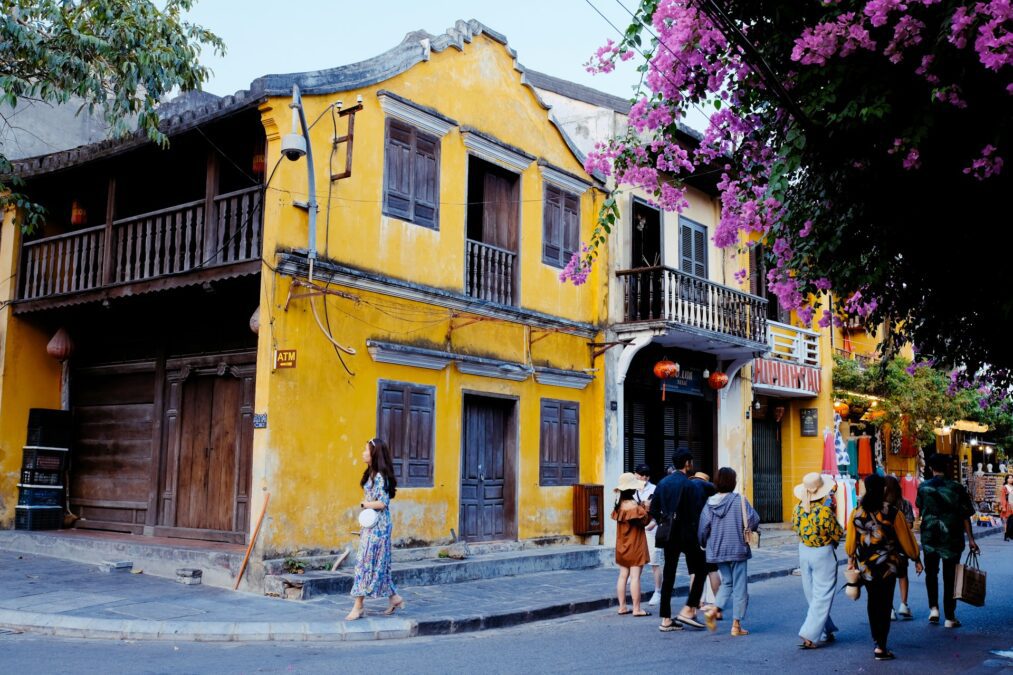
Traveling Vietnam and looking for a Vietnam sleeper bus guide?
While I was traveling around Vietnam, I quickly found out that getting from place to place could be quite the adventure.
One of the coolest things I tried was taking sleeper buses, which are super popular for long trips.
After experiencing it firsthand, I realized these buses really hit the sweet spot with comfort, price, and convenience, especially for overnight journeys.
But like any way of getting around, they have their ups and downs.
In this Vietnam sleeper bus guide, I’m gonna share all the info I picked up about sleeper buses in Vietnam, from how to book them to what to expect once you’re on board, so you can figure out if it’s the right fit for your trip.
Jump to:
- What’s a Sleeper Bus?
- Why Go for a Sleeper Bus in Vietnam?
- Vietnam Sleeper Bus Guide: Types of Buses
- Vietnam Sleeper Bus Guide: How to Book
- Vietnam Sleeper Bus Guide: Cost
- Vietnam Sleeper Bus Guide: What to Expect
- Tips for a Chill Sleeper Bus Experience
- Night Bus Survival Tips
- Do's and Don'ts on a Vietnam Sleeper Bus
- FAQ's

What’s a Sleeper Bus?
A sleeper bus in Vietnam is basically a long-distance bus built for overnight trips, letting you snooze comfortably while you travel from one city to another.
Unlike regular buses with those upright seats, sleeper buses have reclining seats or even beds, which makes for a way more chill and restful ride.
Inside a sleeper bus, you’ll usually find several rows of bunk beds or semi-private spots that are way comfier compared to standard buses.
They’re super popular for late-night trips since you can just lay down and catch some Z’s during those long journeys, making them a smart and budget-friendly way to get around the country.
Compared to regular buses, sleeper buses give you more space and privacy, with some even having curtains or dividers for extra coziness.
Plus, they usually come with better perks like air conditioning, Wi-Fi, and sometimes charging ports for your gadgets.
So whether you’re off to a famous tourist hotspot or a quieter spot, sleeper buses are a solid alternative to flying or taking the train, making them a go-to choice for both locals and travelers in Vietnam.

Why Go for a Sleeper Bus in Vietnam?
Comfort vs. Regular Buses
Sleeper buses are way more comfy than your regular buses because they come with reclining beds or semi-private cabins, letting you kick back and relax during those long trips.
Plus, they have cool stuff like air conditioning, Wi-Fi, and charging ports to make your overnight ride much more enjoyable.
Wallet-Friendly Long-Distance Travel
Sleeper buses are a great budget option for covering long distances in Vietnam.
They usually cost less than flights or trains and save you the price of a hotel room since you’ll be catching some Z’s on the bus.
So whether you want to travel in comfort or save some cash, sleeper buses are a solid pick for long trips in Vietnam.

Vietnam Sleeper Bus Guide: Types of Buses
Reclining Seats: The Good and the Bad
Reclining seat sleeper buses are a pretty straightforward and comfy choice for night travel.
They’ve got seats that lean back quite a bit, so you can catch some Z’s while you’re on the road.
The big plus here is that they’re usually budget-friendly—way cheaper than other options.
But since the seats don’t go completely flat, you might still feel a bit squished and find it tough to stretch out, especially on longer rides.
Fully Reclining Beds: Maximum Comfort and Privacy
If you really want to kick back on long trips, fully reclining beds are the way to go.
These buses come with flat beds that let you sleep like a baby all night.
Plus, many of them have curtains or partitions to give you some privacy, making it a way more chill experience.
They do cost more than the reclining seats, but they’re perfect for anyone looking for a comfy night’s sleep.
Cabin Style: Breakdown of Cabin Buses
Cabin-style sleeper buses come with either bunk beds or semi-private cabins.
Bunk beds are stacked in rows, giving you more privacy than regular reclining seats but still sharing a space with others.
Semi-private cabins are even better, with individual spaces that offer a nice level of comfort and privacy.
These options are great if you want a bit more personal room and don’t mind shelling out a bit extra for it.
If there’s one thing you take away from this Vietnam sleeper bus guide, it should be to book the cabin style always.
It’s not that much of a price jump and it is such a cool experience.

Vietnam Sleeper Bus Guide: How to Book
Online Booking vs. Booking at Stations
Booking a sleeper bus in Vietnam is super easy, whether you do it online or in person at a station.
Going the online route is really convenient since you can snag your seat or bed ahead of time from anywhere you are.
If you prefer to buy your ticket at a bus station, just keep in mind that your options might be more limited, and you might need to speak some Vietnamese.
Online platforms usually give you more freedom to choose your departure times and seats.
Best Websites and Apps to Use
Here are some of the top websites and apps for booking sleeper buses in Vietnam:
- 12Go Asia – A reliable site for booking buses, trains, and flights all over Southeast Asia.
- Vexere – This one’s really popular for booking sleeper buses in Vietnam, and it shows you real-time availability.
- Baolau – Another dependable platform for booking intercity transport, including sleeper buses.
These platforms are super user-friendly, have English options, and let you compare different buses, routes, and prices.
What to Expect When Booking
When you book a sleeper bus, you’ll get to pick your seat or bed type (like upper or lower bunk).
You’ll also need to enter your travel details, like where you’re heading to and from.
After you book, they’ll send you a ticket, usually by email or through the app, and you’ll need to show it before hopping on the bus.
Some services might ask for your passport number, especially if you’re going on an international route.

Vietnam Sleeper Bus Guide: Cost
Typical Price Range
A sleeper bus in Vietnam usually sets you back around $10 to $30 USD for most long trips.
The price can change based on how far you’re going, how comfy the bus is, and which company you pick.
Factors That Influence Price
A few things can affect how much your sleeper bus ticket costs:
- Route: Popular routes, like the one from Hanoi to Ho Chi Minh City, might be pricier than others that aren’t as busy.
- Time of Booking: If you book your ticket early, you’re more likely to score a cheaper deal. Last-minute bookings could make you pay more.
- Season: Prices can creep up during busy times like holidays or festivals when more people are traveling.
Comparison with Other Modes of Transport
Sleeper buses are usually the budget-friendly choice compared to trains or flights, especially for long distances.
For instance, a ticket from Hanoi to Ho Chi Minh City might run you about $20, while a flight could rack up over $50 USD.
Trains might be more comfortable, but they often take longer and can cost more for similar trips.
Sleeper buses strike a solid balance between price and comfort, making them a great option for travelers watching their wallets.

Vietnam Sleeper Bus Guide: What to Expect
Bathroom Breaks: What to Know
When you’re on a sleeper bus in Vietnam, be ready for some bathroom breaks, especially if you’re on a long haul.
Some buses have toilets, but they’re usually pretty basic and might not be the best.
It’s smart to hit the restroom before you hop on and be all set for stops along the way.
Don’t forget to bring your own toilet paper and hand sanitizer since they might not be available in public restrooms.
Driver Skills: Why Experience Matters
On Vietnam’s sleeper buses, the driver is super important for your comfort and safety, especially on those long trips.
Experienced drivers know how to handle the sometimes crazy roads here.
Just be ready for a bumpy ride since sharp turns and sudden stops happen a lot, particularly on winding roads or busy highways.
Frequent Stops: Get Used to It
You should expect quite a few stops during your ride, especially on overnight trips.
These breaks are for resting, picking up or dropping off passengers, and getting some food or bathroom time.
While they might mess with your sleep a bit, they’re totally necessary.
Bugs & Cleanliness: How to Stay Comfy
Even though sleeper buses get cleaned before they leave, there’s still a chance you might encounter some bugs, especially at night.
Bring along some insect repellent and wipes to keep yourself comfy.
It’s also a good idea to have small hand sanitizer and tissues on hand, as cleanliness can vary from bus to bus and route to route.

Tips for a Chill Sleeper Bus Experience
Best Seats: Picking the Comfiest Spot
When you’re booking your sleeper bus, try to grab a seat near the front for a smoother ride—the back can get a bit bumpy.
If you want some privacy, go for a bed with a curtain or a cabin.
Also, think about where your bed is—aisle beds can give you more room to stretch out.
What to Wear: Stay Comfy and Cozy
Dress in loose, comfy clothes so you can kick back and relax on the trip.
It can get a bit chilly on sleeper buses, so a light jacket or sweater is a smart move.
And skip the tight shoes—slip-ons or sandals are way easier to deal with.
What to Bring: Must-Have Stuff for the Ride
Pack a small bag with the essentials like snacks, water, and something to keep you entertained (like a book or headphones).
Don’t forget a portable charger to keep your devices going during the journey.
A neck pillow and a blanket can really up your comfort game on those longer trips.

Night Bus Survival Tips
How to Catch Some Z’s in a Cramped Space
Sleeping on a bus can be a bit of a challenge since space is tight, but there are a few easy tricks to help you catch some shut-eye.
Bring along a neck pillow and a blanket for a cozier experience.
Adjust your seat to find a comfy angle, and don’t forget an eye mask to keep out the light.
If you can swing it, pack a small carry-on to keep your essentials handy, so you don’t have to keep getting up.
Dealing with Noise and Bright Lights
Let’s face it, night buses can get pretty noisy and bright, which totally makes sleeping hard.
To block out the sounds, grab some earplugs or noise-canceling headphones.
An eye mask can be great for blocking out the bright lights from the bus or the screens of other passengers.
If you’re a light sleeper, think about bringing along a sleep aid to help you relax and drift off.
Keeping Your Stuff Secure
With so many people on the bus, it’s super important to keep your things safe.
Keep your valuables in a small bag that you can keep with you, like a backpack or a pouch under your seat. Try not to stash important stuff in the overhead compartments since it’s harder to keep an eye on.
Locking your bag or using a travel lock can also help keep your belongings secure.

Do’s and Don’ts on a Vietnam Sleeper Bus
Do’s:
- Keep your stuff close: Always stash your important things like passports, cash, and gadgets in a secure bag with you.
- Be cool with other passengers: Remember to keep your area tidy, use headphones for your tunes or shows, and try not to be a distraction.
Don’ts:
- Don’t bring big bags on board: These buses don’t have much room inside the bus, so leave the huge suitcases under the bus in storage. Stick to smaller bags to keep it simple.
- Don’t be loud: Keep your chats and music at a chill volume so everyone can relax.

FAQ’s
How much is a sleeper bus in Vietnam?
The cost of a sleeper bus in Vietnam typically ranges from 200,000 to 500,000 VND ($8-$20 USD) depending on the route and bus provider.
Do Vietnam sleeper buses have toilets?
Most sleeper buses in Vietnam do not have onboard toilets, but they make regular stops for bathroom breaks along the way.
What is a sleeping bus in Vietnam?
A sleeper bus in Vietnam is a long-distance bus equipped with reclining beds or semi-private cabins, designed for overnight travel so passengers can sleep during the journey.
Does Vietnam have a sleeper train?
Yes, Vietnam has sleeper trains, which offer similar comfort to sleeper buses, with beds in cabins for overnight travel on long-distance routes.

After trying out sleeper buses in Vietnam, I gotta say they’re an awesome choice for those wanting to save some cash and time.
They might not be the fanciest way to get around, but they’re comfy and a budget-friendly way to travel long distances overnight.
Whether you’re a backpacker or just want to make the most of your trip, sleeper buses are super practical.
Just keep in mind it can get a bit noisy and the space is kinda tight—if you can handle that, you’ll be just fine.
It really depends on what you prioritize and your travel vibe, but for me, sleeper buses were a great way to see more of that amazing country.
I hope you liked this Vietnam sleeper bus guide and it’s helped you plan your journey!




